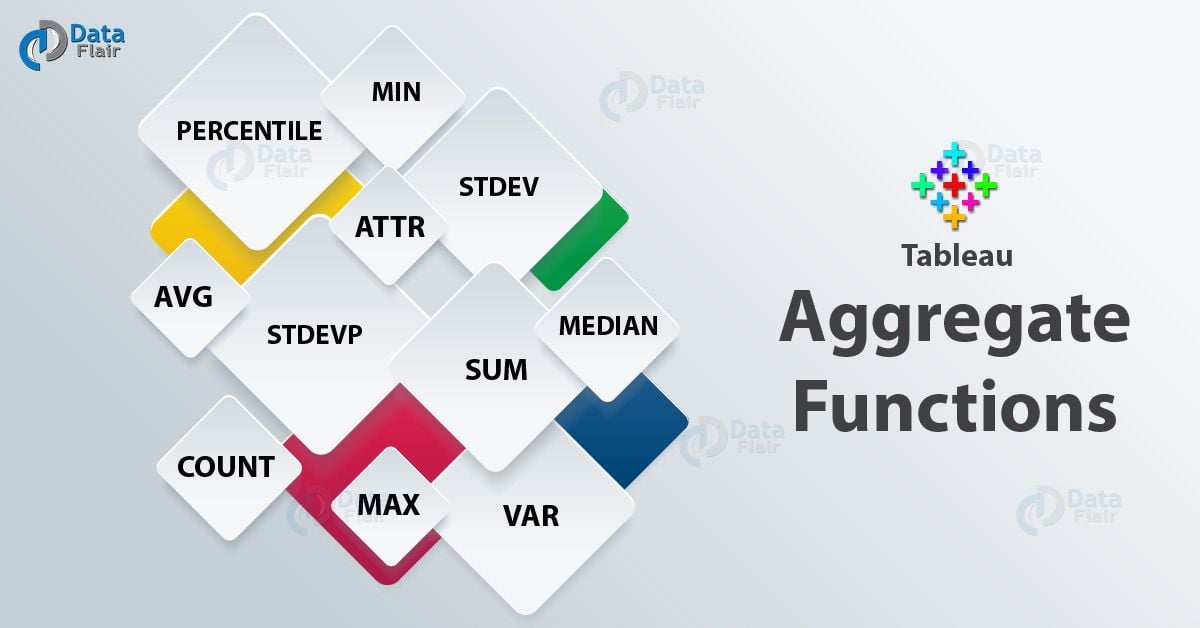Tableau Aggregate Functions with Examples
We offer you a brighter future with FREE online courses - Start Now!!
1. Objective
In Last tableau tutorial, we study on Tableau Date Functions, in this tutorial, we are going to learn about Aggregate Functions in Tableau, different types of Tableau Aggregate Functions and examples of Tableau Aggregate Functions.
So, let us start Tableau Aggregate Functions.
2. Tableau Aggregate Functions
To get to these capacities, essentially select Aggregate from the capacity drop-down rundown on the Create Calculated Field window. In the event that you’d get a kick out of the chance to return to a portion of the past Tableau Essentials articles we’ve discharged on alternate sorts of capacities, you can visit them in the connections toward the finish of the post.
Presently, how about we make a plunge directly into the distinctive kinds of Aggregate Functions with a few cases. A large portion of these capacities will be exceptionally comfortable to anybody with Excel involvement.
Let’s see Tableau Show Me Menu I and Tableau Show Me Menu II in detail.
3. Types of Aggregate Functions in Tableau
This is the list of Tableau Aggregate Functions, let’s discuss them one by one:
a. ATTR perform
ATTR(expression) Aggregate Functions
The ATTR perform, short for an attribute, returns worth|a worth|a price} if all of the rows have one value. If all of the rows don’t match, it’ll come back a price of “*”. Null values are unnoticed. Here’s Associate in Nursing example:
ATTR([City]) = the big apple town
b. AVG perform
AVG(expression) Aggregate Functions
The AVG perform returns the type of all values within the expression. AVG will solely be used with fields that ar numeric. Null values ar unnoticed. Here’s Associate in Nursing example:
AVG([Profit]) = 156
c. COUNT perform
COUNT(expression) Aggregate Functions
A count can come back quantity of things during a cluster. Null values aren’t counted. Here’s Associate in Nursing example:
COUNT(‘OrderID’) = fifty two,909
COUNTD perform
COUNTD(expression)
The CountD perform can come back distinct things during a cluster. Null values aren’t counted. every distinctive item is counted just one occasion. This performance isn’t out there for workbooks that were created before Tableau Desktop v8.2, workbooks that use MS stand out or text files as a knowledge supply, workbooks that use heritage connections and workbooks that use MS Access knowledge sources. Here’s Associate in Nursing example:
COUNTD(‘State’) = fifty
Let’s revise Tableau LOD & Tableau Operators in detail.
d. MAX perform
MAX(expression) Aggregate Functions
The liquid ecstasy perform returns the most of one expression across all records or the most of 2 expressions for every record. the 2 arguments should be identical kind. This performance can come back a price of NULL if either argument is NULL. Here’s Associate in Nursing example:
MAX([Age]) = ninety one
e. MEDIAN perform
MEDIAN(expression) Aggregate Functions
This perform returns the median of one expression, and it will solely be used with numeric fields. Null values ar unnoticed. The median is that the middle variety of a sequence. Here’s Associate in Nursing example:
MEDIAN(4,7,15,27,100) = 15
f. MIN perform
MIN(expression) Aggregate Functions
Similar to the liquid ecstasy perform, the MIN performs returns the minimum of one expression across all records or the minimum of 2 expressions for every record. MIN returns a price of NULL if either of the 2 arguments is NULL. the 2 arguments should be of an identical kind. Here’s Associate in Nursing example:
MIN([Age]) = one
g. PERCENTILE perform
PERCENTILE(expression, number) Aggregate Functions
The centile perform can come back the centile expression adores the given variety. Values that you simply will use for the quantity ar between zero and one. If you utilize zero.50, then it’ll invariably come back the median variety. Here’s Associate in Nursing example:
PERCENTILE([PROFIT],0.66) = 43.66
Let’s read about How to deal with Data Quality Problems in Tableau
h. STDEV perform
STDEV(expression) Aggregate Functions
The STDEV perform stands for normal deviation and could be a applied mathematics perform. it’ll come back the applied mathematics variance for all the values during a given expression supported a sample of the population.
i. STDEVP perform
STDEVP(expression) Aggregate Functions
The STDEVP perform is comparable to the applied mathematics variance perform higher than, however, it’ll instead come back the applied mathematics variance for all of the values during a given expression supported a biased population.
j. SUM perform
SUM(expression) Aggregate Functions
Very merely, this performs sums all of the values in Associate in Nursing expression. Here’s Associate in Nursing example:
SUM(4,5,6) = 15
k. VAR perform
VAR(expression) Aggregate Functions
Another applied mathematics perform, volt-ampere can come back the applied mathematics variance of all the values during a given expression supported a sample of the population.
VARP perform
VARP(expression)
As above, however, the VARP perform can come back the applied mathematics variance of all the values during a given expression supported the whole population.
Related Topics- Tableau Data Blending & Tableau Field Operations
4. Conclusion
In this tutorial, we learned about the various functions available in Tableau Aggregate function with examples. Furthermore, if you have any query, feel free to ask in a comment section.
See Also- Adding Worksheets And Renaming Worksheet In Tableau
For reference
Did you like this article? If Yes, please give DataFlair 5 Stars on Google


